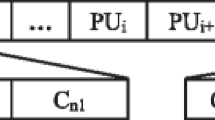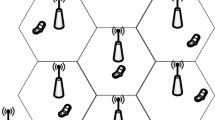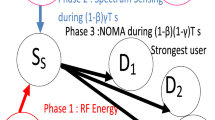Abstract
The coordinated multi point (CoMP) transmission technique is considered a key feature in future wireless network to improve both cell edge users throughput by exploiting interference. However, to provide CoMP transmission several BSs need to be active, which eventually increases network energy consumption. The simultaneous active multiple BSs with different transmission characteristics in heterogeneous environment cause interferences on each other. In this paper, we study the energy efficient radio resource management (EE-RRM) scheme for heterogeneous wireless networks to reduce interference. In particular, our aim is to allocate subcarrier power by optimizing EE metric and minimize interference with knowledge of channel state information between BSs and user equipment. The EE-RRM problem is a fractional programming problem. In order to solve, we use Charnes–Cooper transformation technique and transform it into an equivalent concave optimization problem. The numerical results of our work present the effect of different interference, rate and power thresholds on the EE metric.







Similar content being viewed by others
References
Burchardt, H., & Haas, H. (2013). Multicell cooperation: Evolution of coordination and cooperation in large-scale network. IEEE Wireless Communications, 20(1), 19–26.
Mahapatra, R., et al. (2013). Energy efficient green frame work for future heterogeneous wireless network. Computer Network, 57(6), 1518–1528.
Molisch, A. (2011). Multiple access and the cellular principle. London: Wiley-IEEE Press.
Ali, S., & Leung, V. (2009). Dynamic frequency allocation in fractional frequency reused OFDMA networks. IEEE Transactions on Wireless Communications, 8(8), 4286–4295.
Wang, M., & Ji, T. (2010). Dynamic resource allocation for interference management orthogonal frequency division multiple access cellular communications. IET Communication, 4(6), 675–682.
Andrews, J. G., et al. (2005). Interference cancellation for cellular systems: A contemporary overview. IEEE Wireless Communications, 12(2), 19–29.
Sahin, O., et al. (2013). Interference mitigation through successive cancellation in heterogeneous network. Hindawi Publishing Corporation ISRN Communication and Networking, Article ID 146024, 2013.
Salem, M., et al. (2010). An overview of radio resource management in relay-enhanced OFDMA-based networks. IEEE Communications Surveys and Tutorials, 12(3), 422–438.
Yaacoup, E., & Dawy, Z. (2012). A survey on uplink resource allocation in OFDMA wireless networks. IEEE Communications Surveys and Tutorials, 14(2), 322–337.
Sadr, S., Anpalagan, A., & Raahemifar, K. (2009). Radio resource allocation algorithms for the downlink of multiuser OFDM communication systems. IEEE Communications Surveys and Tutorials, 11(3), 92–106.
Naeem, M., Anpalagan, A., Jaseemuddin, M., & Lee, D. C. (2014). Resource allocation techniques in cooperative cognitive radio networks. IEEE Communication Surveys and Tutorials, 16(2), 729–744.
Rost, P., et al. (2014). Cloud technologies for flexible 5G radio access networks. IEEE Communication Magazine, 52(5), 68–76.
Maleki, A. D., & Abolhassani, B. (2014). New scheduling scheme for green communications in long term evolution networks. IET Communications, 8(14), 2438–2444.
Chand, P., Mahapatra, R., & Parkash, R. (2013). Energy efficient coordinated multipoint transmission and reception techniques: A survey. IRACST International Journal of Computer Networks and Wireless Communications (IJCNWC), 3(4), 370–379.
Ng, D. W. K., Lo, E. S., & Schober, R. (2012). Energy efficient resource allocation in OFDMA systems with large numbers of base station antennas. IEEE Transaction on Wireless Communications, 11(9), 3292–3304.
Chen, X., Feng, Z., & Yang, D. (2012). An energy efficient macro–micro hierarchical structure with resource allocation in OFDMA cellular systems. In 7th international ICST conference on communications and networking in China (CHINACOM).
Arnold, O., et al. (2010). Power consumption modeling of different base station types in heterogeneous cellular networks. In Proceedings of the ICT future network and mobile summit, Florence, Italy (pp. 1–8).
Karmokar, A., Naeem, M., Anpalagan, A., & Jaseemuddin, M. (2014). Energy efficient power allocation using probabilistic interference model for OFDM-based cognitive radio networks. Energies, 7(4), 2535–2557.
Mahapatra, R., & Strinati, E. C. (2011). Radio resource management for self-organized femtocell exploiting location information. In IEEE ANTS 2011, Bangalore, India.
Niyato, D., & Hossian, E. (2008). A non-cooperative game-theoretic framework for the radio resource management in 4G heterogeneous wireless access networks. IEEE Transactions on Mobile Computing, 7(3), 332–345.
Shojafar, M., et al. (2015). Improving channel assignment in multi-radio wireless mesh networks with learning automata. Wireless Personal Communications, 82(1), 61–80.
Madhwal, E., & Mahapatra, R. (2014). Performance analysis of femtocell network in macrocell environment. In IEEE ICECI 2014, Kolkata, India.
Singh, A., & Mahapatra, R. (2013). Energy Efficient analysis of heterogeneous wireless network. In Advance computing conference (IACC) 2013 IEEE 3rd international conference (pp. 531–535).
Chand, P., Mahapatra, R., & Prakash, R. (2014). Energy efficient performance analysis of downlink CoMP in heterogeneous wireless network. In 9th international conference on industrial and information systems, ICIIS-2014, Gwalior, India.
Chand, P., Mahapatra, R., & Prakash, R. (2014). Energy consumption analysis of heterogeneous wireless network using coordinated multipoint transmission technique. In The 11th IEEE India conference on the emerging trends and innovation in technology, INDICON 2014, Pune, India.
Peng, M., et al. (2014). Heterogeneous cloud computing radio access networks: A new perspective for enhancing spectral and energy efficiencies. IEEE Wireless Communication, 21(6), 126–135.
Bourdena, A., et al. (2014). Efficient radio resource management algorithm in opportunistic cognitive radio networks. Transactions on Emerging Telecommunications Technologies, 25(8), 785–797.
GPP TS 36.300 version 10.5.0. (2011). LTE; Evolved universal Terrestrial Radio Access (E-UTRA) and Evolved Universal Terrestrial Radio access Network (E_UTRAN) (Release 10).
GPP TR 36.814 V1.2.1. (2009). Further advancements for EUTRA: Physical Layer aspects.
Schaible, S., & Ibaraki, T. (1983). Fractional programming. European Journal of Operational Research, 12, 325–338.
Boyd, S., & Vandenberghe, L. (2004). Convex optimization. Cambridge: Cambri University Press.
Charnes, A., & Cooper, W. W. (1962). Programming with linear fractional functionals. Naval Research Logistics Quarterly, 9, 181–186.
Author information
Authors and Affiliations
Corresponding author
Appendix
Appendix
Theorem
The optimal power allocation rule that maximizes the total energy efficiency in Eq. (30) is given by the following relation when the capacity is greater than the threshold in constraint C1:
where, \( \beta_{i,k} = ln2(v - \alpha - \lambda_{i,k} + \mathop \sum \nolimits_{i = 1}^{M} ({\emptyset }_{i,k} + \eta_{i,k} )I_{CoMP} ) \) , v, ϕ, λ, η, and α are Lagrange multipliers of Lagranging function L(y, t, ϕ, v, λ, u, η, ∊, α) and \( Q_{i,k} = \frac{{R_{CoMP} }}{{\sigma^{2} + I_{CoMP} }},\, y_{i,k}^{*} = {\text{t}}^{ *} \left( {\frac{1}{{\beta_{i,k} }} - \frac{1}{{Q_{i,k} }}} \right) ^{ + } , \) and \( {\text{t}}^{ *} = \frac{1}{{\mathop \sum \nolimits_{i = 1}^{{N_{B} }} \left( {\frac{1}{{\beta_{i,k} }} - \frac{1}{{Q_{i,k} }}} \right) ^{ + } }} \)
Proof of the Theorem
The Lagranging function of Eq. (36) can be given by:
Suppose, y i,k * and t* denote the optimal solution of the Lagrangian function (37), then the Karush–Kuhn–Tucker (KKT) condition can be written as follows:
where, \( \upphi_{i}\,\,{\rm and}\,\,\in \) are Lagrange multipliers corresponding to interference and sub-carrier usage constraint with element ϕ i ≥ 0 and ∊ ≥ 0 respectively.
α is Lagrange multiplier corresponding to the power constraints. The boundary constraints will be absorbed into KKT conditions when deriving optimal solution.
In order to obtained optimal subcarrier allocation we take derivative of the L w.r.t \( {\text{t*}} \) and y i,k and equate this value to 0 for allocating the sub carrier i to the user k.
Substitute L from (43) into (57) and after some manipulation, we can write following relation:
where, \( \beta_{i,k} = ln2(v - \alpha - \uplambda_{i,k} + \mathop \sum \limits_{i = 1}^{M} \left( { {\emptyset }_{i,k} + \eta_{i,k} } \right)I_{CoMP} ) \). Now, from (47–49), it can be seen that when ∊ = 0, (47) should have strictly inequalities. Therefore, when the rate constraint is satisfied with inequality, we can write Eq. (58) as follows:
where ( · )+ is the non-negative function. Variables \( \uplambda_{i,k} \) and η i,k are the Lagrange multipliers chosen to satisfy the individual BS power constraint and data rate requirement respectively. I CoMP represents the interference of the other BSs created by their power allocations on sub-carrier i. Therefore, the power allocation rule that maximizes the total energy efficiency in Eq. (24) is given by (59) when the capacity is greater than the threshold in constraint C1 has water-filling type policy. The optimal values of λ i,k and η i,k are obtained by using bisection method, due to the concavity of the transformed problem with respect to power allocation variables.
Rights and permissions
About this article
Cite this article
Chand, P., Mahapatra, R. & Prakash, R. Energy efficient radio resource management for heterogeneous wireless network using CoMP. Wireless Netw 22, 1093–1106 (2016). https://doi.org/10.1007/s11276-015-1014-0
Published:
Issue Date:
DOI: https://doi.org/10.1007/s11276-015-1014-0




